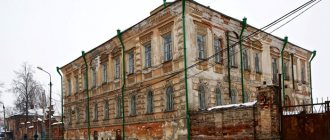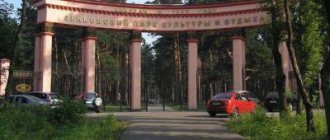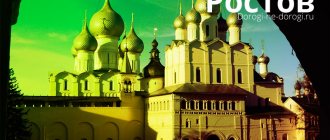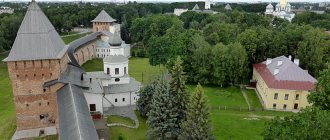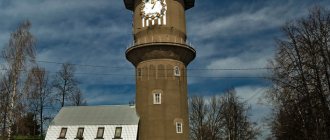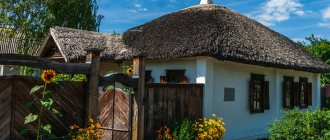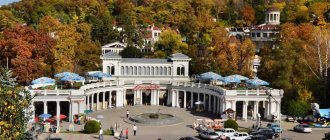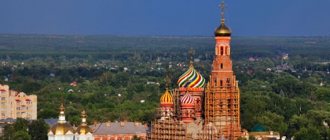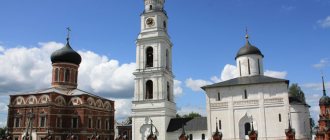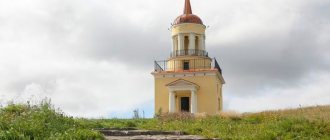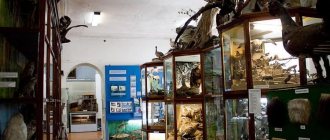The city of Lipetsk, located on both banks of the Voronezh River, is better known as a city of metallurgists, and not a tourist center, which includes the city-museum of Pyatigorsk. Once upon a time, its fame as a resort thundered throughout Russia, although this was already under Emperor Alexander I.
The city was formed thanks to Peter I, who discovered a deposit of brown iron ore (and later mineral springs) on its territory and founded the Lipetsk water-operated metallurgical plants. But only Catherine II gave the settlement that took shape around them the status of a county town. And in 1805, Alexander I issued a decree on the founding of a resort based on local mineral springs. The resort was very prestigious and was available only to representatives of the nobility and bohemians. Even the territory of the resort park (now Nizhny Park) was simply impossible for ordinary city residents to get into.
Monument to Mitrofan Klyuev
In 1903, Mitrofan Klyuev was elected head of Lipetsk. After 9 years, he received the status of “honorary citizen of the city.” All his life he was involved in charity work, opened an orphanage, was the initiator of the construction of a hydroelectric power station, a city telephone exchange, a clinic, a school, and a library. For his services to the city and its residents, a monument was erected to him in 2006. The authors were architect V. Soshnikov and sculptor V. Chelyadin.
Location: Sovetskaya street.
History of ancient buildings in the center of Lipetsk
18:01, July 14, 2021
Society
The buildings located at the intersection of Zegel and International streets are one of the decorations of our city. The archive department of the city administration told about what was located in them in the distant 20th century.
Theological school
In 1875, the honorary guardian of the economic affairs of the Lipetsk Theological School, court councilor Pyotr Avvakumovich Truntsevsky, and his wife Sofya Nikolaevna decided to donate their large stone two-story house on Lebedyanskaya Street (today Zegel Street) to the theological school for the construction of a dormitory for students. However, the school’s classrooms were transferred to the vast Truntsevsky house, and the dormitory was placed in the old building.
By the beginning of the twentieth century, the building of the Lebedyanskaya Street School had become dilapidated and cracks appeared in its walls. In 1913-1914, construction began on a large two-story house designed for six classes, with a gymnasium and the house church of St. Sophia. The work was carried out using red bricks using slag bricks for finishing, which were made at the Sokolsky plant. Due to this, the building acquired an unusual and attractive facade.
The basement housed a boiler room, storage room, archive and servants' quarters. Attached to the house was a brick extension for the kitchen and caretaker's apartment. Steam-water heating was installed. On the side of Gostinaya Street (today Internatsionalnaya) there was a stone fence with a gate and a wicket.
During the war years, this building housed a hospital, then school No. 5. Since 1970, it has been a teacher training institute, and is currently occupied by the health department of the Lipetsk region.
Real school
The Lipetsk Real School was built in 1911 according to the design of the architect V.N. Maksimov at the expense of the city treasury with the participation of the mayor Mitrofan Klyuev. At that time it was the tallest building in the city. It still stands on Segel Street. Here boys were taught the exact sciences and humanities, the leading subjects being physics, chemistry and mathematics. Dancing was also included in the compulsory education program. The cost of studying at the Lipetsk real school was quite high and reached 80-100 rubles per year, so many students, starting from the third grade, gave lessons to children from wealthy families.
During the First World War, the school building housed an infirmary for sick and wounded soldiers. In 1918 it was used by the Field Construction Department of Railways. In the 1930s it housed the House of the Red Army. During the Great Patriotic War, the building housed a military hospital, as evidenced by the installed memorial plaque. From the 1950s to the early 1990s, the main building of the Lipetsk Polytechnic Institute was located here.
Subscribe to our channel in Yandex.Zen
Facebook Twitter
Memorial complex of Eternal Glory to the soldiers of the Great Patriotic War
The complex was founded in May 1965 next to the Evdokievsky cemetery, the grand opening took place two years later. The authors were the architect M. Mordukhovich and the sculptor Y. Grishko. In 1975, the monument was separated from the cemetery by a wall. In 2005, a memorial stele was erected on which the names of Heroes of the Soviet Union born in Lipetsk are engraved. The Eternal Flame burns nearby.
Location: Heroes Square.
Monument to the Teacher
Was opened in 2012. Located in a park near school No. 44. The author was People's Artist A. Kovalchuk. It took a ton of bronze to create it. The monument is a sculpture of a young teacher, towards whom her beloved students are walking. Called to pay tribute to people who prepare children for adulthood and guide them on the right path.
Location: Plekhanov street.
Sculptural composition "Bremen Town Musicians"
The author was Sochi sculptor A. Khalafyan. The sculpture was donated to the city in 2008, and it was installed opposite the entrance to the city children's hospital. These “musicians” are unique thanks to the material that the master used for production. Using a sledgehammer, a forge and a welding machine, he turned aluminum pipes into an artistic composition.
Location: Plekhanov Square - 3.
Monument to Hero Aviators
It was installed at this place in the summer of 1969, when the square was still called “50 years of the Komsomol”. A year before the opening of the monument, the pilots of the Lipetsk air squad, showing courage and professionalism, took the faulty plane away from residential areas, thereby saving dozens of lives of ordinary citizens.
In this accident, L. Krivenkov and S. Sherstobitov died. In memory of their feat, an obelisk was opened opposite the city's Pipe Plant. The author was local artist N.R. Polunin. In 2003, reconstruction was carried out, and full-length sculptures of heroes were installed near the monument.
Location: Aviator Square.
Nativity of Christ Cathedral
The decree on the construction of the cathedral was issued by Catherine I at the end of the 18th century. The author of the Orthodox church was the Swiss architect T. Adamini.
The end of the construction period dates back to 1842. During the Soviet years it fell into disrepair, was partially looted and closed to parishioners. Only in 1991 the temple was opened again. A unique object inside it is the Lipetsk Icon of the Mother of God of Passion.
Location: Cathedral Square - 4.
Architectural monuments of the Lipetsk region, presentation for a local history lesson on the topic
Slide 1
Architectural monuments of the Lipetsk region
Slide 3
Arkhangelskaya Sselki The stone church of the Archangel Michael in the village of Sselki was built in 1895-1905. on the site of an old wooden church built back in 1699. Two side altars were consecrated in the name of St. Nicholas the Wonderworker and St. Cosmas and Damian. At the bell tower at the beginning of the 20th century. there was a large bell weighing 2.5 tons, three bells weighing 300 kg and small bells, and 6 in total. In April 1922, representatives of the Soviet government confiscated 79 spools and 70 shares of silver utensils from the Arkhangelsk Church, and in 1937 the temple was completely closed. In March 1990, its restoration began. On the Feast of the Exaltation of the Holy Cross, the first divine liturgy was celebrated.
Slide 4
In the village of Veshalovka, the Church of the Icon of the Sign of the Blessed Virgin Mary: The church was built in 1768-1794 at the expense of Y.A. Tatishchev in his estate “Znamenskoye” according to the project of V.I. Bazhenova. The Church of the Sign is a unique religious building of the late 18th century, which has no direct analogues even in the works of Bazhenov himself. The temple was built in the style of Russian pseudo-Gothic. The peculiarity of this style direction was the combination of planning and volumetric-spatial principles of classicism with the use of freely interpreted forms of ancient Russian architecture and individual motifs of European Gothic. One of the most striking examples of “Russian pseudo-Gothic” was the Church of the Sign.
Slide 7
In the Chaplyginsky district there is the Trinity Cathedral: Construction of the Holy Trinity Cathedral began at the beginning of the 19th century. The temple became a decoration, a pearl of the architectural appearance of the city. Today the Trinity Cathedral can rightfully be considered a symbol of Ranenburg-Chaplygin. The temple consists of two volumes: the church building itself, built in 1818, and the bell tower, which was built later. It is unknown who developed the temple project. In 1931, the cathedral suffered the sad, but quite ordinary for those times, fate of many churches of God in Russia: first - a ban on holding church services, then - transformation into a warehouse and even... into a kerosene shop. Liturgical vessels and other church utensils made of precious metals, confiscated by the Bolsheviks, disappeared without a trace. Iconostases were destroyed and icons were looted. The Soviet authorities had to begin restoration work on the temple building in 1974, but only in 1989 the cathedral was returned to the Russian Orthodox Church and handed over to the believers.
Slide 9
The Novo-Kazan Cathedral is located in Lebedyan: The cathedral was built with funds from parishioners and significant donations from the merchant M.I. Igumnova. The cathedral building is organically included in the ensemble of Cathedral Square. The history of the ensemble’s construction dates back to the beginning of the 19th century, when a project for the development of the entire quarter was being developed. In its center there is a cathedral and a separate four-tier bell tower, and along the perimeter there are buildings of shopping arcades. The latter were built in the 1870s in eclectic style.
Slide 10
The history of the Troekurovsky St. Dimitrievsky Convent begins from the moment when the saint of God, the Rev. Hilarion Troekurovsky, agreed to the proposal of the landowner of the village of Troekurovo, Ivan Ivanovich Raevsky, in 1824 to settle on his estate in a cell specially built for him near the Dimitrievsky Church. From that time until the end of his days, the ascetic lived in Troekurovo, and popular rumor began to call him the Troekurovsky recluse. After the revolution, the Troekurovsky Monastery suffered the fate of all Russian Orthodox monasteries. In 1930, local authorities finally closed the monastery, but many sisters lived until the end of their days on the territory of the monastery, the main part of which in Soviet times was adapted into a fruit and berry processing plant. On July 13, 1999, the discovery of the honest relics of Hilarion Troekurovsky took place. They were transferred to the Archangel Michael Church, where they rest to this day, again showing miracles of miracles and healings.
Slide 12
In the Zadonsk region, Church in the name of the Life-Giving Trinity: Built in 1884-1897. The author of the project is Voronezh provincial architect A.A. Cui. Eclecticism using motifs of pseudo-Russian and pseudo-Byzantine styles. Trinity Church was the cathedral church of the Holy Trinity Tikhon Convent, founded in 1888 and closed in the late 1920s. The monastery buildings subsequently housed a children's colony, then they were used for housing and the economic needs of a bread factory. The monastic territory has undergone modern development.
Slide 13
Zadonsky Male Nativity of the Mother of God Monastery: Founded by two elders-schemamonks, Cyril and Gerasim, natives of the Moscow Sretensky Monastery, who brought around 1610 a copy of the Vladimir Icon of the Mother of God, which later became famous as a miraculous one. The monastery contains the relics of St. Tikhon of Zadonsk, to which people flock from all over Russia to venerate them. In 1990, Vladimir Cathedral and part of the monastery buildings were returned to the Russian Orthodox Church. The first bishop's service in the cathedral took place on August 26, 1990, on the day of memory of St. Tikhon of Voronezh, the Wonderworker of Zadonsk. Currently, the monastery has been restored; The management of the monastic brethren, including more than 200 novices and 60 monastics, is carried out by the abbot, Abbot Tryphon (Golubykh). The monastery receives pilgrims and operates a number of free pilgrimage hotels.
Slide 17
Women's St. Tikhon's Monastery of the Transfiguration St. Tikhon's Diocesan Monastery of the Transfiguration was formed on the ruins of the Tikhon's male monastery. St. Tikhon's Monastery was founded in the 19th century on the site of the monastery of St. Tikhon of Zadonsk. Saint Tikhon loved to visit this quiet, deserted place in the wilderness for solitude and prayer. Here, alone with wonderful nature, indulging in the thought of God, he created his life’s work, “Spiritual Treasure Collected from the World.” On the bank of the Prohodnya River the saint built a spring, which is now healing.
Slide 20
In the Dankovsky district, the Church of the Tikhvin Icon of the Mother of God: The church was erected in 1861–1878. Pseudo-Russian style. The two-story, single-apse, cross-domed, five-domed church is built of brick on a white stone plinth. The walls are plastered and painted blue, which effectively sets off the white architectural details. The facades have a three-part division. Built in the pseudo-Russian style and being a characteristic example of religious architecture of the second half of the 19th century, it organically fits into the ensemble of the central square and is the main dominant feature in the development of the city of Dankov.
Slide 21
In the Yeletsk region, the Ascension Cathedral: on August 22, 1845, the foundation stone of the temple. Construction time was 44 years. The building is overwhelming in the enormity of its size: the height of the cathedral together with the cross is 74 meters, length 84 meters, width 34 meters. According to experts, this is the third largest Orthodox church after the Cathedral of Christ the Savior and St. Isaac's Cathedral in Russia [source not specified for 400 days]. Located on Red Square - the central part of Yelets.
Slide 23
The Borki estate (Borkovsky Castle) is the only architectural monument (regional) in the English Gothic style in the Lipetsk region. Located in the village of Borki, Terbunsky district, Lipetsk region. From 1901 to 1915, the estate belonged to the cousin of Emperor Nicholas II, Grand Duke Andrei Vladimirovich Romanov.
Slide 25
In Polibino, on the right bank of the Don River, opposite the old Dankovsky settlement, there is the estate of the famous philanthropists Nechaevs. The center of the estate is a palace in the Empire style, built at the end of the 18th century according to the design of the architect V. I. Bazhenov. The estate also included: an English park, a huge garden and a cascade of ponds, an arena, a stable and other buildings. The remains of the buildings are partially preserved among the fragments of the old park. Before the revolution, L.N. Tolstoy, I.E. Repin, I.K. Aivazovsky, K.A. Korovin, V.D. Polenov, V.V. Vasnetsov, I. V. Tsvetaev, A. N. Benois, Olga Knipper-Chekhova, Anna Akhmatova. By Decree of the Council of Ministers of the RSFSR No. 624 of December 4, 1974, the Nechaev Palace, the Shukhov Tower near the palace, a park with ponds and a stable were declared architectural monuments protected by the state
Slide 26
The landmark of the estate is the openwork steel water tower, designed by engineer V. G. Shukhov. This is the world's first hyperboloid-shaped structure and the world's first tower made in the form of a load-bearing mesh shell. The height of the hyperboloid shell of the tower is 25.2 meters (excluding the heights of the foundation, reservoir and viewing superstructure). The tower was built by V. G. Shukhov for the largest pre-revolutionary All-Russian Industrial and Art Exhibition in Nizhny Novgorod, which took place from May 28 (June 9) to October 1 (13), 1896. After the exhibition ended, it was bought by Yu. S. Nechaev-Maltsov. The tower was transported disassembled to Polibino and installed by V. G. Shukhov next to the Nechaev palace.
Slide 27
The currently existing estate complex in the village of Balovnevo was formed in the last quarter of the 18th - early 19th centuries. Its construction was started by Matvey Vasilyevich Muromtsev (1734-1799), lieutenant general, first Tula governor. Having started the construction of the estate, Matvey Vasilyevich invited the best specialists to create it; it is no coincidence that many consider V.V. to be the author of the estate house project. Rastrelli, and the temple project is attributed to the work of V.I. Bazhenova. Catherine stayed in Balovnevo for several weeks, which is confirmed by her more than thirty letters kept in the estate at the beginning of the 20th century. Here, under a glass cover in the office, the amazon, boots and gloves of the empress were kept. After the revolution, the estate was plundered. In 1918, the palace burned down, and then its central volume was dismantled into bricks down to the zero level. In the 1920s, outbuildings were destroyed. In the 1930s, the iron was removed from the roof of the Vladimir Church and the church fence was broken. A grain warehouse was set up in the temple, after which cracks appeared in its walls. There was a glacier in the Muromtsev crypt.
Slide 28
Lipetsk
Slide 33
GUESS... 1 Trinity Cathedral in Chaplygin Ascension Cathedral in Yelets Male Zadonsk Nativity - Theotokos Monastery
Slide 34
GUESS... 2 Church of the Archangel Michael in the village of Sselki Church of the Icon of the Sign of the Blessed Virgin Mary in the village of Veshalovka Novo-Kazan Cathedral in Lebedyan
Slide 35
GUESS... 3 Church of the Archangel Michael in the village of Sselki Church of the Icon of the Sign of the Blessed Virgin Mary in the village of Veshalovka Novo-Kazan Cathedral in Lebedyan
Slide 36
GUESS-KA... 4 Troyekurovsky Holy Demetrius Convent Male Zadonsky Nativity of the Mother of God Monastery Female Holy Trinity Transfiguration Monastery
Slide 37
GUESS... 5 Troekurovsky Holy Demetrius Convent Male Zadonsky Nativity of the Mother of God Monastery Female Holy Trinity Transfiguration Monastery
Slide 38
GUESS-KA... 6 Troekurovsky Holy Demetrius Convent Male Zadonsky Nativity of the Mother of God Monastery Female Holy Trinity Transfiguration Monastery
Slide 39
GUESS-KA... 7 Borki estate in the Terbunsky district Nechaev estate in the village of Polibino Muromtsev estate in the village of Balovnevo
St. Tikhon's Transfiguration Diocesan Monastery
Construction of the monastery was completed in 1865. It functioned until 1919, that year the mass separation of church and state began in the country. The monastery and churches were looted. The monastery was empty until the early 90s of the last century.
Today, the Trinity Cathedral, the Assumption and Transfiguration churches, and the Cell of St. Tikhon are open to the public on its territory. Now more than 100 sisters live here permanently, 55 of them are nuns. Not far from the main entrance there is a holy spring. People from all over the region come to fetch its water. A swimming pool has been organized.
Location: Zadonsk city.
Sights of the Lipetsk region
Yelets is a city in the Lipetsk region, which is proud that it is mentioned in chronicles earlier than about Moscow. Yes, this is a very ancient city and every street is imbued with history.
Yelets is a city in which a large number of attractions of the Lipetsk region are concentrated. We can introduce you to only a small part of it:
- Vvedenskaya Church is the oldest stone building in the city
- The Temple of the Yeletsk Icon of the Mother of God is a symbol of the city; according to legend, it was this icon that stopped Tamerlane’s troops from invading Moscow
- The Grand Duke's Church will amaze you with its unique architecture; it was erected in honor of the visit of Yelets by Grand Duke Mikhail
- The Ascension Cathedral is the most famous building in Yelets. It is considered the third largest in Russia.
The city has a large number of attractions associated with the name of I.A. Bunin, who studied at the local gymnasium. Yelets is also famous for its ancient craft - lace weaving. Yelets lace has small patterns and a delicate openwork background. And they are woven on wooden sticks - bobbins.
Another district of the Lipetsk region, in which a large number of attractions are concentrated, is Dolgorukovo.
Among the attractions:
- a spring and font in the west of the village of Tsarevka, where a huge number of pilgrims come
- ruins of the composer Vasilenko's estate in Tsarevka
- stone church of the Life-Giving Trinity, built in 1820 (the village of Bratovshchina)
- estate of the Bykhanov landowners (the village of Bratovshchina)
- Church of the Epiphany, erected in 1836 at the expense of parishioners
- Church of the Assumption 1777
- the estate of the landowner Vedrov, built at the end of the 19th century, etc.
Zadonsk is another city in the Lipetsk region, rich in attractions. This small town can rightfully be called the spiritual center of the region; thousands of pilgrims from all over the country flock here. Most people come here to visit the monasteries and take a dip in the holy spring, but that's not all this town has to offer. Not far from it there is a safari park, where you can ride horses, visit the reconstruction of a Scythian fortress, feed an ostrich and other animals, and also take a dip in the holy spring located in the park. Fans of active recreation can stop by the rope town and test their strength on rope courses. Near the village of Kamenka there are Don Conversations - an outcrop of Devonian rocks that form 7 large rocks.
Chapel of Saints Peter and Paul
In 1806, the Church of the Nativity of Christ burned down in its place, after which it was decided to install a chapel here. The first stone was laid in the winter of 1814. In Soviet times, the chapel was partially dismantled, and the icon of the Savior disappeared from it. In 1996, the collection of voluntary donations for its restoration began. 5 years later, the chapel of the Supreme Saints Peter and Paul was built almost from scratch. In 2012, the first liturgy was held here after it was given the status of a temple-chapel.
Location: Revolution Square.
Historical reference. Interesting facts about Lipetsk
* Already 7000 years ago ancient people lived in the Lipetsk region
* The city of Lipetsk is the first Russian resort. It appeared during the reign of Tsar Alexander I.
* Lipetsk is one of the youngest regional centers
* In 1806, there was a terrible fire in Lipetsk that destroyed the entire city. After the fire in Lipetsk, the massive construction of stone buildings began.
* The linden tree has become the official symbol of Lipetsk.
* On the territory of the city there are springs of Mineral Waters. The water from them is very tasty and beneficial for the digestive system.
* The names of the family of streets in Lipetsk are related to the space theme.
* Higher education can be obtained at 18 universities.
* The most interesting part of the city, from a historical point of view, is the Cathedral Square area. There are many temples, cathedrals and ancient buildings.
* Lipetsk is the largest industrial center, as it is home to the giant Novolipetsk Metallurgical Plant.
* Lipetsk is famous for its famous singing fountains, which delight citizens and guests of the city every evening.
Church of the Life-Giving Trinity
An architectural monument of the century before last. Construction was completed in 1850. A few years before the start of World War II, the temple was closed. During Soviet times, a community of evangelical Christian Baptists was located inside it. In 2010, the Church of the Life-Giving Trinity was returned to the subordination of the Russian Orthodox Church. Open to parishioners.
Location: Kochetkova street - 45.
Lipetsk Regional Museum of Local Lore
The founder of the museum in 1909 was local historian M.P. Trunov. Nine years later the museum was nationalized. In 1955 it acquired the status of a regional museum. In 1991, the main exhibition and temporary exhibitions moved to the building of the former House of Political Education. The collections of Aivazovsky, Vasnetsov, Pasternak and others are kept here. Lectures are held on the history of the region's development.
Location: Lenin street - 25.
House-Museum named after. G.V. Plekhanov
It is a branch of the Lipetsk Regional Museum of Local Lore. The exhibition is located in the house that was bought by the father of the future public figure and philosopher in 1867. In 1928, a revolutionary museum was opened. In 1995, the political exhibition disappeared and was completely replaced by an exhibition related to the various stages of Plekhanov’s life. In 1998, a life-size sculpture of him was installed next to the house.
Location: Plekhanov street - 36.
The main attractions of Lipetsk
Among the main attractions, of course, is the monument to Peter I, located on the square of the same name. It is, perhaps, a symbol of the city, because Peter the Great made a huge contribution to its development. On the same square there is a color and musical fountain that will delight not only adults, but also children.
In general, many fountains have been built in the city: two of them are located in the Upper Park, on Lenin Street, a cascade of fountains descends from Cathedral Square to Komsomolsky Pond. The Komsomolsky pond itself is also decorated with a fountain, where you can feed the ducks. There is also a monument dedicated to the 300th anniversary of the city - a ship with sails.
Another symbol of the city is the obelisk to Emperor Peter I, made by order of the merchant Pavel Nebuchinov, who rested and was treated at the Lipetsk mineral waters resort. The obelisk was installed in 1839 and restored in 2000.
Next to it is the Lower Park, on the territory of which the resort was once located. Be sure to visit the park, because there is a mineral spring, the water of which is rich in iron, magnesium, calcium and other trace elements. A monument to the People's Volunteers was erected in the Lower Park. In fact, this is a monument to the terrorists who killed Alexander II - you must admit, not many cities in the world can “boast” of such structures. It was in Lipetsk that the People's Will organization arose, whose members chose mass terror as their course.
On the territory of the Lower Park there is another local attraction that is interesting for children - the zoo. 3.5 thousand different species of animals and birds live and grow in it. Children can also be entertained by visiting the Puppet Theater.
Guests of the city will be delighted with its beauty by Theater Square, where the Academic Drama Theater named after Leo Tolstoy is located, which has many honored and people's artists of Russia. There are also several beautiful fountains installed here.
On the right bank of the Voronezh River lies the Bykhanov Garden - a favorite place for walks for local residents. Near the garden there is a monument to the Aviators - a pedestal on which a combat aircraft is installed.
In the Oktyabrsky District you can stroll through Victory Park, where 40 species of trees and shrubs grow.
Museums of the city of Lipetsk:
- House-museum of G.V. Plekhanov. Plekhanov is considered the founder of Marxism in Russia, an opponent of the Bolsheviks and the October Revolution. But his cozy wooden house tells visitors not about his struggle with the Bolsheviks, but about his everyday life.
- Lipetsk Regional Museum of Local Lore. The museum was founded in 1909.
- Museum of Folk and Decorative Arts.
- House of General Gubin. There is an art gallery here.
- Art Museum of V.S. Sorokin.
- Regional exhibition hall.
- Center for Contemporary Art.
Lipetsk is also famous for wood painting. Here is the only factory in Russia producing Lipetsk patterns.
Art Museum named after V.S. Sorokina – House of the Master
It was opened on December 14, 1992. Since 2007 it has become a branch of the Lipetsk Regional Art Gallery. The museum's collections contain works not only by V.S. Sorokin, but also by other outstanding creators of the 20th and 21st centuries, including I. Golitsyn, A. Golubkina, V. Shevchenko, Z. Serebyakova, G. Basyrov and others.
There are temporary exhibitions with a total area of more than 100 square meters. m. Thematic evenings are held several times a month, musical groups of the city perform classical music, interesting guests give master classes and lectures.
Location: Lenin street - 2.
There are so many beautiful places on Lipetsk land! There were many great people here, each of whom left their own story here. This history is manifested not only in legends and chronicles, but also in architecture. Many historical architectural monuments have survived to this day. This article will tell you about famous people and architectural monuments of Lipetsk land.
- Balovnevo
- Ascension Cathedral in Yelets
- Ancient Assumption Church
- Gubin House
- Znamenskoye
- Palna-Mikhailovka
- Polibino
- The Sheremetev estate in the village of Borki
- Nativity of Christ Cathedral
Balovnevo
The village of Balovnevo is located seven miles southwest of the city of Dankov, formerly in the Ryazan province (now Lipetsk region). The name of the village was first found in scribe books in 1626. It was named after the owner of Dankovo and ataman Balovnev.
The currently existing manor complex was formed in the last quarter of the 17th - early 19th centuries. Its construction was started by Matvey Vasilyevich Muromsky, lieutenant general, first Tula governor. Then the estate was successively owned by the Muromtsevs: Matvey Matveevich, Leonid Matveevich, Nikolai Leonidovich, and from 1900 - the famous painter E.E. Volkov-Muromtsev, maternal heir.
Having started construction of the estate, M.V. Muromtsev invited the best specialists to create it. It is no coincidence that many consider the author of the manor house project to be V.V. Rastrelli, and the temple project is attributed to the work of V.I. Bazhenova. The Muromtsev estate resembled one of the royal summer residences. They said that all this was built to receive Catherine, whose personal secretary and favorite was M.V. Muromtsev.
Currently, among the surviving buildings in the village of Balovnevo, the Vladimir Church, located not far from the palace, attracts special attention. The church was built in a classical style, but has an unusual volumetric-spatial composition and some decorative details. The peculiarity of the temple is the absence of an apse, but the refectory, equal in width to the temple part, with a high roof, up to the level of the third tier of the temple, which gives the church a resemblance to the buildings of Western Europe. The similarity is enhanced by the presence of two bell towers.
After the revolution, the estate was plundered. In 1918, the palace burned down, and then it was dismantled into bricks. In 1920, outbuildings were destroyed. In the 1930s, the iron was removed from the roof of the Vladimir Church and the church fence was broken. A grain warehouse was set up in the temple. There was a glacier in the Muromtsev crypt.
In recent years, the estate complex, which is a monument of federal significance, has been slowly dying. The outbuildings of the palace are abandoned and destroyed, the garden and parks are cut down.
Bibliography
Balovnevo // Lipetsk Encyclopedia: in 3 volumes / ed.-comp. B.M. Shalnev, V.V. Shakhov. - Lipetsk, 1999. - T. 1. - P. 78. Vladimir Church / / Travel around the Lipetsk region / comp. V.F. Polyansky, N.V. Markov, A.F. Martynov. - Voronezh, 1971. - P. 140 - 143. Klokov, A.Yu. Balovnevo. Muromtsev estate / A.Yu. Klokov // Russian provincial estates / comp. R.V. Andreeva, A.F. Popova. - Voronezh, 2001. - P. 324 - 332. Konstantinov, V. The temple is being reborn: [revival of the temple in the village. Balovnevo] / V. Konstantinov / / Testaments of Ilyich. - 2004. - September 23. - WITH. . Merlev, A. How the temple of God was dying: [the plight of the Vladimir Church in Balovnevo] / A. Merlev, A. Kosyakin / / Lipetsk newspaper. - 2002. - February 27. - P. 2 - 3. Ovcharova, T. Two pearls of Bazhenov: [Church of the Sign in Veshalovka and Vladimirskaya in Balovnevo] / T. Ovcharova // Metallurgist. — 2001.—July 13. - P. 30. Rudakov, L.E. In the footsteps of legends / L.E. Rudakov. - Voronezh, 1980. - P. 112 - 114. Ancient estates (Balovnevo, Polibino) // Guide to the Lipetsk region / comp. Z. I. Esipova, G. V. Tarasova. - Lipetsk, 2003. - P. 48. Tambovskaya, A. Trees die standing...: [the plight of the parks Polibino, Troekurovo, Trubetchino, Balovnevo] / A. Tambovskaya / / Lipetskaya newspaper. - 2003. - October 15. — P. 4.
Ascension Cathedral in Yelets
Ascension Cathedral, a monument of architectural architecture. Located in Yelets, Lipetsk region. Located on Red Square - the central part of Yelets. Built from 1845 to 1889. The author of the project is K.A. Tone. The height of the Ascension Cathedral together with the cross is 74 m, length - 84 m, width 34 m. It took 44 years to build, but remained unfinished. The bell tower, designed 10 meters above the base of the dome, remained unfinished.
The Ascension Cathedral consists of a cubic quadrangle topped with five onion-shaped domes resting on octagonal light drums; from the refectory and the unfinished bell tower. The altar part of the Ascension Cathedral has three semicircular apses. The temple is four-pillar, one-story. In the exterior design of the building, the architect used stylized forms of Russian and Byzantine architecture, adopted for small ancient Russian churches. These include an arcature belt, keel-shaped kokoshniks, pipe columns, and daisy-shaped platbands. At the same time, narrow high windows are elements of classicism.
The interior of the Ascension Cathedral is decorated with a three-tiered iconostasis made of gilded carved wood, designed by Moscow architect A.V. Kaminsky. In general, the Yelets Ascension Cathedral is a huge artistic exhibition; in the temple part alone there are more than 220 wall paintings, paintings, and icon paintings, most of which were painted by outstanding Russian artists - the Wanderers K.V. Lebedev and A.I. Korzukhina.
The decoration of the refectory now includes about 150 works of art. Undoubtedly, the wall paintings and icons of the cathedral, different in their artistic merits and manner of execution, are a unique historical and artistic property of Yelets.
Bibliography
Ascension Cathedral // Yelets / ed. V.P. Gorlova. - Voronezh, 1978. - pp. 143 - 144. Ascension Cathedral / / Lipetsk Encyclopedia: in 3 volumes / ed. - comp. B.M. Shalnev, V.V. Shakhov. - Lipetsk, 1999. - T.1. — P. 212-213. Ascension Cathedral // Guide to the Lipetsk region / comp. Z.I. Esipova, G.V. Tarasova. - Lipetsk, 2003. - P. 82. Gorlov, V. Interior decoration: [decoration of the Ascension Cathedral] / V. Gorlov / / Red Banner. - 1991. - July 17. Grishaev, A. Grand-ducal symbol of the ancient city: [Ascension Cathedral] / A. Grishaev // Golden Key. - 1998. - N 14. - P. 5. Tyagunov, V. The unrealized plan of the architect: [Ascension Cathedral] / V. Tyagunov / / Lenin Banner. - 1991. - February 20. Fedorova, O. Revival: [About the Ascension Cathedral in the city of Yelets] / O. Fedorova // Lipetsk news. — 1998. — Aug. 28. — P. 12.
Ancient Assumption Church
The Ancient Assumption Church is an architectural monument of republican significance at the end of the 17th century and is the oldest building in the city. Located on the street. Saltykov-Shchedrin - the former settlement "Monastyrka", which was named after the monastery "Paroyskaya Hermitage", founded at the beginning of the 17th century.
The church is bell-free - an octagon on a two-height quadrangle with a semicircular apse and a chapel of St. Nicholas the Wonderworker. It was built in several stages, which can be seen in the masonry. The year of construction is unknown. The northwestern chapel of St. Nicholas the Wonderworker was consecrated by Ryazan Metropolitan Stefan (Yavorsky) in 1701.
Features of the temple: the altar is oriented to the northeast, there is an underground passage. To the north of the temple on the slope there was a wooden bell tower (the foundations have been preserved), built in 1885. On the northern and western sides there was a necropolis. On the south-eastern side in 1878, according to the design of A. Andreev, a wooden chapel was built over the source, where the icon of the Mother of God “Life-Giving Spring” miraculously appeared. According to legend, Peter I visited this spring. On the southwestern side of the temple there was a two-story clergy house built in the second half of the 19th century. The Paroiskaya Hermitage monastery was abolished in 1764. The surviving Assumption Church was without a parish.
The church was closed in 1938 “at the request of the sanitary inspectorate”, after which it was severely destroyed, completely losing the iconostasis, paintings and interior details. The restoration of the temple, which began in the 1970s, was completed after its transfer to the regional museum in 1991. Until 1996. In the church premises there was an exhibition dedicated to the history of metallurgical production and metalworking in the region.
Bibliography
Grishaev, A. The underground secret of the city: [underground passages of the Ancient Assumption Church] / A. Grishaev // Golden Key. - 1994. - N 12. - P. 7. Ancient Assumption Church of Lipetsk / / Lipetsk Encyclopedia: in 3 volumes / ed.-comp. B.M. Shalnev, V.V. Shashov. - Lipetsk, 1999. - T. 1. - P. 358. Ancient Assumption Church in Lipetsk // Rudakov L.E. In the footsteps of legends / L.E. Rudakov. - Voronezh, 1980. - P.99 - 104. An icon from the water fell into the temple: [history of the Ancient Assumption Church] // De facto. - 1998. - April 17 - 22 - St. 1. Medvedev, V.A. Road to the temple: [Ancient Assumption Church] / V.A. Medvedev // Lipetsk newspaper. — 2002.—February 21—S. 6. Architectural monument - Ancient Assumption Church / / Koltakov V.M. Memorable places of Lipetsk / V.M. Koltakov. — Voronezh, 1976.—S. 5 - 7. Architectural monument - Ancient Assumption Church / / Travel around the Lipetsk region / comp. V.F. Polyansky, N.V. Markov, A.F. Martynov. — Voronezh, 1971.—S. 28 - 29. Tyagunov, V. A few more materials about the Ancient Assumption Church in Lipetsk / V. Tyagunov / / Holy Rus'. — 1994.—Sept. 29. Tyagunov, V. St. Nicholas chapel of the Ancient Assumption Church is 300 years old / V. Tyagunov / / De facto.-2001.-18 - 20 Dec.-S. 2. Shurygina, T. Ancient Assumption Church / T. Shurygina / / Golden Key. — 1999.—N 3. — P. 5.
Gubin House
On Lenin Street in Lipetsk there is one ancient building with columns, known as the house of General Gubin. The history of its construction goes back to the distant past: the end of the 13th - beginning of the 19th centuries. Historical documents tell us that the ancestors of A.S. Pushkin's maternal side began the construction of this building. Here was their city estate, and their summer “dacha” was located in the village of Korenevshchino. At the beginning of the 19th century, the Pushkins finally moved to Moscow, then to St. Petersburg. And the Lipetsk estate was acquired by the widow of the district solicitor Grishin. The widow, in turn, resold the dismantled house to the staff doctor of the Lipetsk resort F.I. Turovsky, who built the best house in Lipetsk at that time and surrounded it with a large park with ponds. The Turovskys owned this house until the 1890s. According to documents from 1896, the estate was owned by A.M. Gubina.
In 1917 General Gubin's house was confiscated and transferred to the jurisdiction of the Council of Local People's Judges, and in 1918. The military commissariat moved there. In the 30s, General Gubin lived in Yelets. His daughter Evgenia Aleksandrovna Glinka told Yelets local historians that A.S. visited the Lipetsk resort during one of the fashionable summer seasons. Pushkin. He danced in their house, at balls given by the Turovskys. Fedor Ivanovich was for some time the director of Lipetsk Mineral Waters. Pushkin A.S. I came here even before my marriage to meet a certain artist Kachanova. At the same time, he went to the village of Kapitanschino, Butyrskaya volost, to see N. Zamyatin; all the residents of the village, which once belonged to the poet’s great-grandfather Alexei Fedorovich Pushkin, came out to meet him. It is difficult to judge how plausible this message is. Evgenia Aleksandrovna Glinka died a long time ago.
In 1974 By decree of the Council of Ministers of the RSFSR, the building was taken under state protection as a monument of history and culture of federal significance. In 2001 It was decided to house an art gallery in this building. The building is undergoing restoration work.
Bibliography
Gubin's House // Travel around the Lipetsk region / comp. V.F. Polyansky, N.V. Markov, A.F. Martynov. — Voronezh, 1971.—S. 40 - 41. Klokov, A. Waiting for the buffet table: [Gubin’s House; restoration of the building] / A. Klokov / / Lipetsk News. - 2005. - March 9. - P. 5. Kukrak, S. Legends and were of the old house: [The House of Gubin and celebrities] / S. Kukrak // Lipetsk newspaper. - 1997. - July 6. — P. 5. Monument to the art gallery: [Gubin House] // De facto. - 2001. - 20 - 22 February. - P. 2. Smirnov, N. Once again about Gubin’s house: [restoration] / N. Smirnov // Lipetsk newspaper. — 2005. — April 16. — P. 6.
Znamenskoye
The Znamenskoye estate is located on the territory of the Lipetsk district of the Lipetsk region in the village of Veshalovka (the former village of Znamenskoye of the Lipetsk district of the Tambov province, after 1917 it became part of the village of Veshalovka).
The history of the village of Znamenskoye can be traced through documents from the second half of the 17th century and belongs to the ancient Tatishchev family. The Tatishchev family originates from the Smolensk princes of Solomersky. In 1804, the Tatishchevs sold the Znamenskoye estate to artillery captain Ivan Iosifovich Kozhin. After the death of I.F. Kozhina Znamenskoye goes to Mikhail Ivanovich Kozhin. After the death of M.I. Kozhin, his eldest son Alexander Mikhailovich Kozhin will become the owner of the estate. After the death of A.I. Kozhina (43 years old), the estate is inherited by his wife Margarita Semyonovna (owned it until 1917).
The site of the estate in the village of Znamensky was chosen on the high northern side of the ravine. On its left side stood the Church of the Sign of the Icon of the Mother of God; to the right, 300 meters away, stood a manor house. The beginning of the development of the estate is considered to be 1768, when the church was founded. It was built in 1784. The final date of construction is considered to be 1794.
The author of the project for the Church of the Sign was the then young architect Vasily Ivanovich Bazhenov. The architecture of the church is unusual for central Russia: it was built in a pseudo-Gothic style and more closely resembles a temple in Western Europe.
The estate was built on lands with close groundwater, so drainage channels were laid around the buildings. To the south there was a cascade of ponds. 300 meters east of the manor house, behind the pond, a large orchard was laid out. Outbuildings and services were located behind the orchard. In 1918, the manor house burned down. The Lipetsk district government sold the estate for scrap.
The Znamenskoye estate ceased to exist in the 20s of the last century. Only part of it has survived to this day: the Church of the Sign, the chapel with the family tomb of the Kozhins (the last owners of the estate), the corner tower of the large palace, a neglected orchard, the remains of a park, and washed out dams of ponds.
Znamenskoye is an architectural monument of the 17th - 19th centuries of federal significance, but so far it is “protected” only on paper.
Bibliography
Veshalovka / Lipetsk Encyclopedia: in 3 volumes/ed.-compiled by B.M. Shalnev, V.V. Shakhov.—Lipetsk, 1999.—T. 1. - pp. 197-198. Architectural monument in the village of Veshalovka / / Guide to the Lipetsk region / comp. Z.I. Esipova, G.V. Tarasova. - Lipetsk, 2003. P. 25 - 26 Rudakov, L.E. In the footsteps of legends / L.E. Rudakov.—Voronezh, 1980. — P. 111 — 112. Seleznev, N.P. Znamenskoye / N.P. Seleznev // Russian provincial estates / comp. R.V. Andreeva, L.F. Popova.—Voronezh, 2001.—S. 310 - 315. Estate “Znamenskoye” / Lipetsk Encyclopedia: in 3 volumes / ed.-comp. B.M. Shalnev, V.V. Shakhov. - Lipetsk, 2001. - T. 3. - P. 394. Masterpiece in Veshalovka // Travel around the Lipetsk region / comp. V.F. Polyansky, N.V. Markov, A.F. Martynov.—Voronezh, 1971. — P. 138 — 140.
Palna-Mikhailovka
One of the “rare oases of culture” is the village of Palna-Mikhailovka, located 15 km north of the city of Yelets. Near this village, on the Palna River, there is an old landowner’s estate, which since the end of the 18th century belonged to the famous freemason M.V. Pervago. M.V. Pervago was very fond of decorative art and he himself planned a large park and garden on 26 acres in the Palnovskaya estate. The house was built in the Russian Empire style. Its design was compiled by the famous architect A.L. Vitberg. Vitberg's Palnovsky house went down in the history of Russian architecture as an exemplary monument of wooden classicism in the first third of the 19th century. The palace burned down twice and was rebuilt, but still retained the charm of its original, neoclassical style thanks to the fact that the popular master of decorative painting D.B. was invited to Palna. Scotty. Scotti's grisaille paintings (in one or two tones) were distinguished by sculptural clarity and created the illusion of bas-relief. Currently, the paintings have not been preserved, since the house burned down twice. There is another interesting building in the same estate. This is a small church-mausoleum, built according to the plan of the famous Moscow architect D.I. Gilardi (1788-1845). This is a round, blank building with a dome on a drum, decorated with one portico on the west side. With its strict simplicity and ponderous monumentality, it resembles the Roman Pantheon.
Subsequently, opposite the old palace on the opposite bank of the river, another two-story palace in the Gothic style was erected. It was badly damaged during the war (1941-1945), but has not yet lost its original appearance. The Gothic style of this estate is emphasized by pyramidal oak trees.
Palna-Mikhailovka became known as a bright provincial center of Russian cultural life in the middle of the 19th century, when the estate was owned by Mikhail Alexandrovich (1820-1858) and Alexander Alexandrovich (1830-1913) Stakhovich. The brightest personality here was, of course, Mikhail Aleksandrovich Stakhovich - poet, writer - playwright, folklorist, musician-theorist, local historian. Outstanding writers, poets, artists, and actors often visited the owners of the estate.
Bibliography
Eletskikh, A. The Stakhovich family and the Terbunsky region / A. Eletskikh / / Lighthouse. - 2003. - September 23. - P. 2. Krasnova, S. Noble nest Palna-Mikhailovka / S. Krasnova / / Lipetsk Land: historical heritage: culture and art / ch. ed. A.M. Tarunov. - St. Petersburg, 2003. - P. 160-165. Krasnova, S. Palna-Mikhailovka - a rare oasis of culture / S. Krasnova / / Russian provincial estates of the 18th - early 20th centuries. - Voronezh, 2001. - P. 242-258. Palna-Mikhailovka and Stakhovichi // Travel around the Lipetsk region / comp. V.F. Polyansky, N.V. Markov, A.F. Martynov. - Voronezh, 1971. - P. 145-158. Stanovlyansky district. Manor in Palna-Mikhailovka // Guide to the Lipetsk region: in 2 hours / comp. Z.I. Esipova. - Lipetsk, 2004. - Part 2. - P. 102-104. The ancient park should not be abandoned: [the ancient park of the Stakhovichi estate] // Zvezda. - 2003. - December 16. — P. 3. The Stakhovichi estate in the village of Palna-Mikhailovka // Guide to the Lipetsk region / comp. Z.I. Esipova, G.V. Tarasova. - Lipetsk, 2003. - pp. 87-89.
Polibino
A manor complex in the village of Polibino (Storozhevoye) in the Dankovsky district of the Lipetsk region, the former Dankovsky district of the Ryazan province. The village is located on the right bank of the Don River, opposite the old Dankovsky settlement. It was first mentioned in the census books of the Dankovsky district in 1676, the name was named after the owner, steward B.F. Polibina. Later, the estate passes to the Nechaev family.
The Nechaev noble family descends from Fyodor Nechaev, a boyar of the Grand Duke Simeon the Proud (1300). The history of the estate is directly connected with the name of three representatives of this noble family: Dmitry Stepanovich Nechaev, his son Stepan Dmitrievich Nechaev and son S.D. Nechaeva Yuri Stepanovich Nechaev-Maltsev. The new owners of the village, the Nechaevs, are rebuilding a manor complex here with a palace of “Rastrelli architecture” and a vast park. The estate housed the first museum of the history of the Battle of Kulikovo, where finds from the Kulikovo field were collected. This landmark of the estate was noted by P.P. Semenov-Tyan-Shansky.
The landmark of the estate is the water tower of a mesh structure 45 meters high, with a reservoir with a capacity of 9,500 buckets, designed by the outstanding engineer V.G. Shukhova. Purchased by Yu.S. Nechaev-Maltsev at the Nizhny Novgorod Industrial Exhibition in 1896. This is the first construction of a mesh structure in the history of technical thought.
Gradually, over the course of the 18th-19th centuries, a manor complex of rare beauty and historical significance was created in Polibino. The complex, which was fully formed by the end of the 19th century, included: a palace, an English park, a huge garden and a cascade of ponds, outbuildings, including an arena and a stable, a water tower and a pumping station, a laundry with a dryer and other buildings. All this was created by three generations of owners (Nechaevs).
On November 2, 1971, the estate was declared a monument of republican significance. In the same year, the Polibino estate was declared a monument of federal significance and, despite the destruction and loss, was included in the excursion route.
Today, the palace and the Shukhov water tower are in disrepair. The arena was completely dismantled into bricks, the stable was destroyed. Landscape buildings today are in an abandoned state or destroyed. The garden and park complex, which is a natural monument, is slowly dying: the park is being built up, most of the garden was uprooted back in 1976.
The palace is guarded on a voluntary basis by local historian Ivan Kuzmich Laktionov.
Bibliography
Klokov, A. Polibino / A. Klokov / / Lipetsk Encyclopedia: in 3 volumes / ed.—comp. B.M. Shalnev, V.V. Shakhov. - Lipetsk, 2001. - T. 3. - P. 80. Klokov, A. Polibino. Nechaev estate / A. Klokov / / Russian provincial estates / comp. R.V. Andreeva, L.F. Popova. - Voronezh, 2001. - P. 274-282. Melikhova, G. Riddles of Polibino / G. Melikhova / / Testaments of Ilyich. — 2001. — Jan. 23, Jan. 30, Feb. 6, Feb. 13. Rudakov, L.E. In the footsteps of legends / L.E. Rudakov. - Voronezh, 1980. - pp. 114-115. Ancient estates (Balovnevo, Polibino) // Guide to the Lipetsk region / comp. Z.I. Esipova, G. V. Tarasova. - Lipetsk, 2003. - P. 49. Tambovskaya, A. Trees are dying while standing...: [the plight of the parks Polibino, Troekurovo, Trubetchino, Balovnevo] / A. Tambovskaya / / Lipetsk newspaper. — 2003. — Oct. 15. — P. 4.
The Sheremetev estate in the village of Borki
The estate complex in the village of Borki is an architectural monument of the last quarter of the 19th century, built in the Romanov style.
The palace, built of rubble stone and gray stained sandstone, used to make the elements of the palace that are most susceptible to weathering, has been preserved. Outbuildings made in the same style have been preserved. The southern facade of the palace, the center of the volumetric composition of which was a two-story building with a round tower, faces the slope of a deep ravine occupied by an orchard. The park is planned in the English style, decorated with exhibitions of large glacial boulders of gray sandstone. The park overlooks the steep bank of the Olym River.
The estate was the center of the Sheremetev estate with developed field farming and a stud farm. Since 1893, on the territory of the estate there was a zemstvo tree nursery, where seedlings of various species were grown.
The interiors of the palace were destroyed in 1941 as a result of a fire. Later, the arch of the palace was laid, the roof and part of the window openings were modified. At the same time, the self-regenerating park was cut down. Currently, its central alley is clearly visible. For a long time, the Borkiv secondary school was located in the manor house.
Bibliography
Eletskikh, A. The death of the castle: [history of the castle in the village. Borki] / A. Eletskikh / / Lighthouse. — 2003. — April 1, April 5. Eletskikh, A. At the Sheremetevsky Castle / A. Eletskikh / / Work -7. - 2001. - July 19. — P. 20. Castle in Borki // Lipetsk Land: historical heritage: culture and art / ch. ed. A.M. Tarunov. - M, 2003. - P. 183. The Sheremetev estate in the village of Borki // Guide to the Lipetsk region. - Lipetsk, 2003. - P. 71-72.
Nativity of Christ Cathedral
This architectural monument as a whole was formed from 1791 to 1842. In accordance with the traditional scheme, the cathedral has three components: the church itself, the refectory and the bell tower. The bell tower was built in 1825 - 1835. The refectory - after 1839 and consecrated in 1842. There are five thrones.
On highly solemn days, up to 2,500 people gathered in the cathedral. The cathedral had an unusually rich interior decoration. Inside, the cathedral resembled an art gallery. On the walls there were about 30 paintings by famous artists of the Italian school. Until 1917, the cathedral had: running water, steam heating with a steam pump, electric lighting with 800 light bulbs. The church was surrounded by an iron fence on a brick foundation with two gates and three wickets.
After 1917 the cathedral was looted and closed on June 26, 1931. Until the 50s, the cathedral was used as a warehouse, but it was decided to transfer the dilapidated building to the local history museum. In 1957, its restoration began, and for many years the cathedral housed a local history museum. In 1991, at the request of the residents of Lipetsk, the cathedral was handed over to believers. On January 8, 2001, the relics of 82 holy ascetics of the Kiev-Pechersk were transferred to the Nativity Cathedral.
Bibliography
Alexandrova, D.V. City center - in the center of history: [Cathedral Square. Nativity Cathedral] / D. Alexandrova / / Youth Bulletin.—2005. — Apr 22 - P. 12. Kolesnichenko, G. New solo for striking clocks: [the main city clock will work again at the Nativity Cathedral] / G. Kolesnichenko // Lipetsk newspaper. - 2004. - N 47.-S. 3. Medvedev, V.A. Road to the temple: [Christ Nativity Cathedral] / V.A. Medvedev // Lipetsk newspaper. - 2002. - February 21. - P. 6. Architectural monument - Cathedral - Rudakov L.E. In the footsteps of legends / L.E. Rudakov.—Voronezh, 1980.—S. 130 - 135. Architectural monument Cathedral on Lenin Square // Travel around the Lipetsk region / comp. V.F. Polyansky, N.V. Markov, A.F. Martynov.—Voronezh, 1971.—S. 41 - 44. Saiko, S. Will serve great-grandchildren: [from the history of the Nativity Cathedral] / S. Saiko / / Lipetsk news. - 1997. - December 19 - p. 15. Cathedrals. Nativity Cathedral / / Lipetsk Encyclopedic Sovar / comp. V.V. Shakhov. — Lipetsk, 1994.—S. 402.
In the photo of the introductory part of the material - Lipetsk diocesan administration on Lenin street, 34
Peter the Great Square
Until June 24, 2003 it was called Karl Marx Square. After the installation of the monument to Peter I in 1996, dedicated to the 300th anniversary of the Russian fleet, local residents among themselves began to call this square after the Russian emperor.
Only 7 years later the city administration officially approved this name. Now on the territory of the square there is a city hall, a light and music fountain, and a monument to the Tsar. The Victory Parade, cultural events, concerts, and rallies are held annually.
Location: Lenin street - 2.
LiveInternetLiveInternet
Saturday, October 11, 2008 22:14 + to quote book We moved to Lipetsk from Kazakhstan in 1996. I won’t say that I fell in love with the city, but it seemed beautiful to me, but at the same time terribly inconvenient. There is a peculiarity in Lipetsk: it is constantly being rebuilt, so historical values are leaving it irrevocably. I think everyone will see this in my report and photographs, old and new.
A fortified Slavic settlement on the site of the modern city existed even before the start of the Mongol-Tatar invasion. It was located on a steep hill, protected from the north, south and west by inaccessible slopes. On the flatter eastern side, an earthen defensive hill was erected, the remains of which have survived to this day. In the center of the settlement there was a princely house, and artisans lived around it. Lipetsk was first mentioned in chronicles in 1283-1284, during the period of battles between the Russians and the Mongol-Tatar conquerors. In 1284 the city was completely destroyed, and over the next few centuries there is no mention of it. The village of Malye Studenki Lipskie, located on the site of the modern city, was first mentioned in chronicles in the first half of the 17th century. The year 1703 is considered to be the year of the founding of Lipetsk (City Day is celebrated on the 3rd Sunday of July). It was then, on the orders of Peter I, on the Lipovka River, at its confluence with the Voronezh River, that the construction of iron factories began for the needs of the Russian fleet and army, which provided great support in supplies during the Northern War. By this time, the factories began to be considered large, and occupied second place in Russia in the production of cast iron. Few people know that Lipetsk is one of the first urban resorts in Russia. The Lipetsk Mineral Waters resort was founded in 1805 and soon gained all-Russian fame. In terms of the quality of natural remedies - mineral waters and ferruginous mud - Lipetsk was compared with the best European resorts. Thanks to the resort, the city was quickly improved and had “more the appearance of some wealthy German town than a Russian district town, with the idea of which you always associate the concept of dirt, dust, cramped conditions and untidiness.” At different times, outstanding architects worked here - Voronikhin, Melnikov, Mashkov. By the end of the 19th century, there was a general opinion that Lipetsk “belongs among the most beautiful and attractive district cities of the Russian Empire.” The Lipetsk resort was visited by famous writers and poets, musicians and actors, populist revolutionaries, and Russian soldiers and officers healed their wounds here. In the summer, the resort hosted magnificent balls, fireworks and illuminations, concerts and performances. The foundation of the resort is associated with the name of Peter the Great. He is considered the discoverer of Lipetsk mineral springs. Numerous legends have been preserved telling how he discovered a healing spring here, treated himself and drew up rules for using mineral waters. These legends have no documentary evidence. Perhaps their emergence is due to the fact that the springs were located on the territory of the Lipa iron factories, founded in Peter the Great’s time for military purposes. The main products were garrison and ship cannons, anchors, fuses, halberds, swords, which played an important role in arming Peter's army and navy. With the closure of iron factories at the end of the 18th century, mineral springs began to attract the attention of people of the common and noble classes. There were no conditions for treatment then; patients who wanted to take mineral baths brought containers with them, and the water was heated with cast iron cores heated over a fire, which were left in large quantities after the closure of iron factories. The gentlemen coming to the waters were observed by the Lipetsk district doctor Vander, who in 1800 submitted a report to the Medical College about favorable cases of treatment.
Modern Lipetsk has changed a lot since that time, and now it has ceased to be a resort, but has turned into a metallurgical city with all the ensuing consequences. This is what Lipetsk looked like 200 years ago
In the photo in the background you can see the Nativity Cathedral, which was completed in 1842. It still stands today and is the center of Lipetsk. Several photos of the resort Lipetsk. To be honest, when I looked at some of them, I didn’t believe that this was Lipetsk. However, seeing the buildings in the background that exist to this day, she still agreed that it was him.
The pond is still in this photo today. however, it became smaller and was decorated with fountains. There are no churches for a long time, and in the place where the right church is located there is now the Metallurg stadium.
All the buildings in the photo were demolished, but the chapel was restored about 4 years ago and now it looks like this
And if you climb the descent stairs, you will get to Cathedral Square - one of the main squares of Lipetsk, as I already wrote, here is the Nativity Cathedral, a monument to Lenin and the administration of Lipetsk. By the way, many people like to say that Lenin next to the church is unique, don’t believe them. In many cities in the central parts there is Lenin next to the church.
I found an interesting photo on the Internet; it turns out there was an arch in Lipetsk too. Now there are not even any memories left of her, like the walls on the left in the photo.
Just, the road under the arch to the right went to Petrovsky Descent. and to the left onto Dvoryanskaya Street (now Lenin). The street was the most beautiful; the name suggests that only the elite lived here. However, only the house of General Gubin remained, which was restored a year ago and an exhibition hall and an Upper Park were opened there.
Lenina Street goes into the area that leads to another Lipetsk plant - Svobodny Sokol. I don’t even know if it works now.
Continued here
| Categories: | Journey to the Center of the Earth |
Tags:
Lipetsk
Cited 3 times Liked by: 1 user
Like share
0
Like
- 1
I liked the post - Quoted
- 0
Saved
- Add to quote book
- 0
Save to links
Liked1
0
